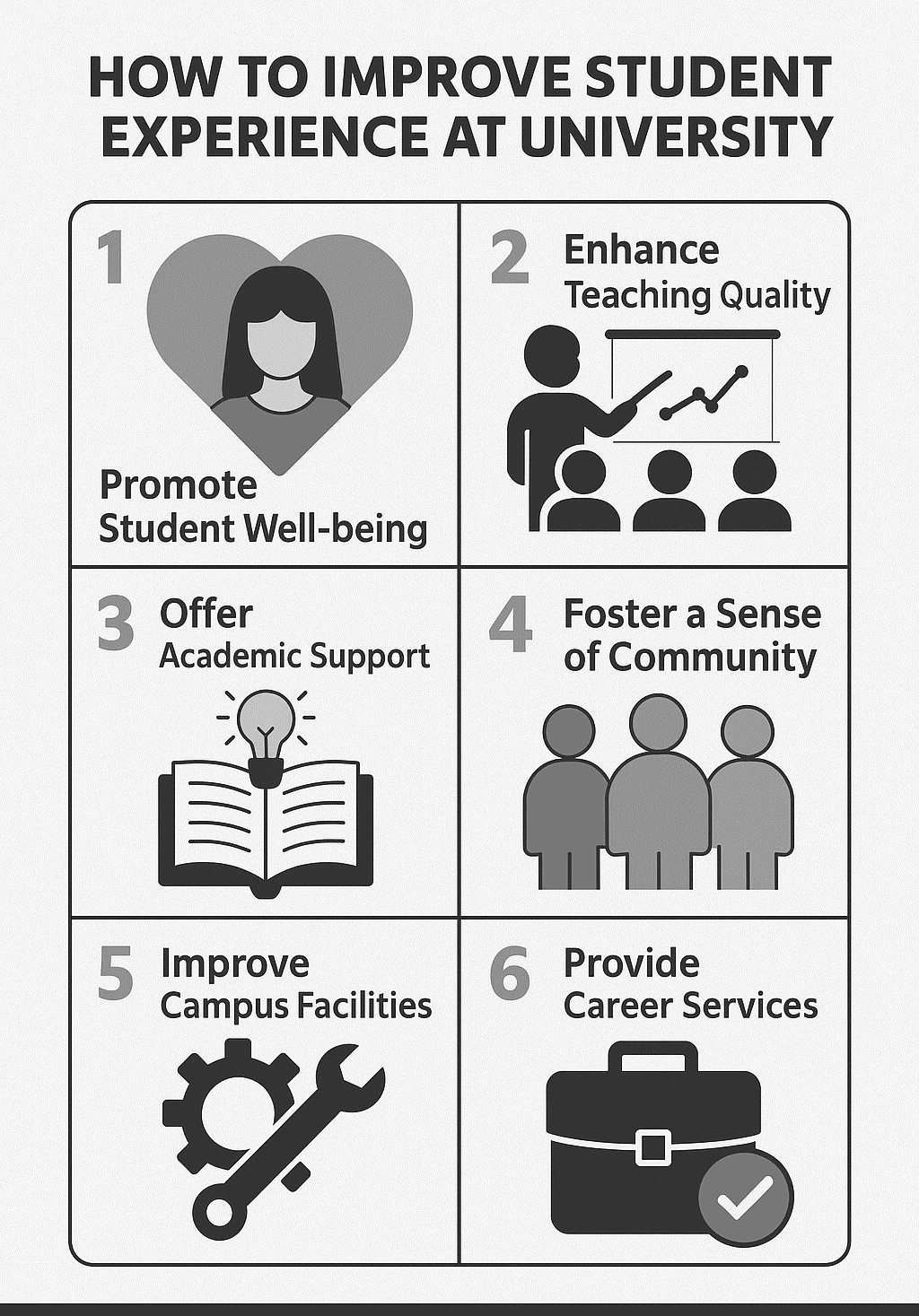
For most students, university isn’t just about attending classes. It’s about the entire experience—how they live, learn, and grow. From the moment they set foot on campus, their journey is shaped by everything from the classroom environment to how safe they feel walking home at night.
Yet, many universities still fall short. A large number of students report feeling stressed, disconnected, or unsupported.
The 2023 Times Higher Education Student Experience Survey revealed that students now prioritize support services, mental health resources, and a sense of belonging more than ever before, even above academic rankings.
This article outlines clear, research-backed strategies to enhance the university student experience—academically, socially, emotionally, and practically.
Table of Content
- What Student Experience Really Means
- Academic Support Systems That Make a Difference
- Better Teaching Practices for Real Engagement
- Improving Mental Health and Emotional Support
- Building Community and Connection
- Making Campus Safe and Inclusive
- Preparing Students for Life After University
- Listening to Student Feedback
- Affordable and Transparent Financial Support
- Digital Infrastructure That Works
- Role of Faculty in Student Experience
- Diversity and Inclusion Across the Campus
- Making All Students Feel Heard
- Conclusion
- Frequently Asked Questions
What Student Experience Really Means
The student experience encompasses every aspect of campus life. It’s not just about lectures or assignments. It includes how students interact with teachers, how safe they feel, whether they get the help they need, and if they feel accepted for who they are.
Good experiences improve retention and satisfaction. Poor ones lead to dropouts, frustration, and missed opportunities. A 2022 report by the Higher Education Policy Institute found that feeling unheard or isolated is one of the most significant predictors of early dropout.

Academic Support Systems That Make a Difference
Personalized Academic Advising
Students are more likely to succeed when they have someone to guide them through course selection, time management, and long-term goals. One-on-one sessions help clarify academic pathways and reduce confusion.
Accessible Learning Resources
A library with extended hours, online journals, writing support centers, and peer tutoring programs creates an environment where students feel supported, not overwhelmed.
Constructive Feedback Culture
Feedback should be regular, clear, and valuable. Vague comments like "needs improvement" don’t help. Instead, when students receive actionable advice, their confidence and performance improve.
Better Teaching Practices for Real Engagement
Active Learning Over Passive Listening
Sitting through long lectures with minimal interaction doesn’t benefit most students. Studies from Harvard’s School of Education show that students retain more when they engage in discussions, problem-solving, and hands-on activities.
Inclusive Classroom Strategies
Inclusive teaching involves adapting to diverse learning styles. That includes offering materials in various formats, allowing multiple forms of participation, and avoiding a one-size-fits-all teaching model.
Use of Technology (When It Adds Value)
Smartboards and online forums are great when used correctly. Recorded lectures, digital Q&A platforms, and flexible deadlines for online submissions can support students who juggle jobs or live off-campus.
Improving Mental Health and Emotional Support
On-Campus Counseling Services
Mental health shouldn’t be a hidden issue. Having licensed counselors, walk-in clinics, and peer support groups can help students manage stress, anxiety, and life changes.
Normalizing Mental Health Discussions
Workshops, classroom check-ins, and peer campaigns can help shift campus culture from silence to one of support. Students should never feel ashamed to seek help.
Flexible Academic Policies
Life happens. Universities that offer flexible deadlines and absence policies—without penalizing students—help prevent academic burnout.
Building Community and Connection
Orientation With Purpose
A few campus tours and name games won’t cut it. First-year orientation should include sessions on finding academic help, building friendships, and managing emotional health.
Peer Mentorship Programs
When new students have a trained and experienced student to turn to, it reduces stress and increases their sense of belonging. Some universities report a 12% improvement in retention through mentorship.
Events That Encourage Inclusion
Organize cultural nights, interest-based clubs, and open mic events. These provide students with opportunities to connect, express themselves, and feel seen.
Making Campus Safe and Inclusive
Physical Safety Measures
Well-lit pathways, emergency call buttons, and late-night campus transportation services give students peace of mind, especially for women and marginalized students.
Clear Anti-Harassment Policies
Students must feel safe reporting abuse, discrimination, or misconduct. A confidential, student-friendly process should be in place.
Disability-Friendly Spaces
Classrooms, libraries, and restrooms must be accessible. That includes wheelchair ramps, screen readers, and support staff.
Preparing Students for Life After University
Internships and Work Experience
Students want to feel ready for the workforce. Universities that connect students with paid internships, research jobs, and co-op programs build bridges to real careers.
According to the AAC&U 2022 report, employers strongly value students with hands-on experience. It’s one thing to write about a topic. It’s another to have applied it in a real setting.
Career Counseling That Starts Early
Don't wait until the final year. Career advice, resume assistance, and networking opportunities should be introduced in the first or second semester.
Teaching Practical Life Skills
Students benefit from learning how to budget, manage time, and navigate workplace expectations. Workshops on these topics boost their readiness for life after graduation.
Listening to Student Feedback
Anonymous Surveys With Real Impact
Feedback is only valuable when it is acted upon. Universities should regularly survey students and then share what changes they’ve made based on the input.
Student Representation on Decision Panels
Let students sit at the table—literally. Involving them in discussions about course changes, facilities, and university planning builds trust.
Affordable and Transparent Financial Support
Clear Tuition and Fee Breakdown
Confusing or hidden costs can cause stress. Make it simple: show all fees, explain their purpose, and avoid last-minute additions.
Scholarships Without Bureaucracy
Overcomplicated application processes discourage students from applying. Streamline them, publish deadlines early, and offer help with forms.
Emergency Funding Options
Students sometimes face unexpected financial issues. Short-term grants or zero-interest loan programs can keep them from dropping out.
Digital Infrastructure That Works
Online Portals for Everything
From registration to assignment submissions, a well-organized portal helps reduce paperwork and saves time.
Mobile Compatibility
Not every student uses a laptop full-time. Ensure that course materials, timetables, and announcements are easily accessible on mobile phones.
Fast and Reliable Internet Access
Whether it's in the dorm, the library, or campus cafés, students need a stable internet connection to study, attend online classes, and conduct research.
Role of Faculty in Student Experience
Being Approachable and Available
When students feel intimidated by professors, they stop asking questions. Open office hours, friendly communication, and genuine interest go a long way.
Respecting Students’ Time and Lives
Avoid assigning unrealistic workloads or scheduling assessments too close together. Understand that many students work part-time or commute long hours.
Encouraging Honest Discussions
Whether it's current events, classroom disagreements, or personal opinions, students should feel safe expressing themselves.
Diversity and Inclusion Across the Campus
Welcoming International Students
Provide airport pickups, host family programs, and cultural support groups. Feeling at home helps students focus more effectively on their learning.
Gender and LGBTQ+ Support
Safe spaces, student alliances, and respectful campus dialogue are necessary. Everyone deserves to feel respected and valued.
Language and Accessibility
Offer translation services, basic language classes, and orientation sessions in multiple languages. This supports non-native speakers and improves engagement.
Making All Students Feel Heard
Student-Run Publications and Radio
Give students a voice through newspapers, podcasts, and community blogs. These platforms reflect student concerns and provide a genuine outlet for expression.
Regular Town Hall Meetings
A space to air grievances, share feedback, and brainstorm solutions. It shows that the administration is listening and responsive.
Social Media Feedback Channels
Many students are more comfortable expressing themselves online. Maintain an official platform where suggestions and concerns can be submitted easily.
Conclusion
Improving the student experience isn’t a one-time fix. It’s a continuous process that requires listening, adapting, and putting students at the center of every decision.
From better teaching practices to safe campuses, from accessible mental health support to real-world career preparation—each step matters. When students feel heard, valued, and supported, they not only perform better but also experience greater overall well-being. They thrive. And that’s what university should be all about.
Frequently Asked Questions
1. How can universities improve mental health support for students?
Offer on-campus counseling, peer groups, and flexible academic policies to reduce pressure and stigma.
2. What makes teaching more engaging for students?
Utilize active learning, incorporate diverse learning styles, and foster open and respectful communication.
3. Why is student feedback important?
It helps universities identify problems and improve services. When used correctly, it builds trust and satisfaction.
4. How can campuses become more inclusive?
Focus on accessibility, cultural sensitivity, and support for marginalized groups. Involve students in creating inclusive spaces.
5. What are simple ways to boost the student experience?
Improve communication, build community through events and mentorship, and offer transparent financial and academic support.


